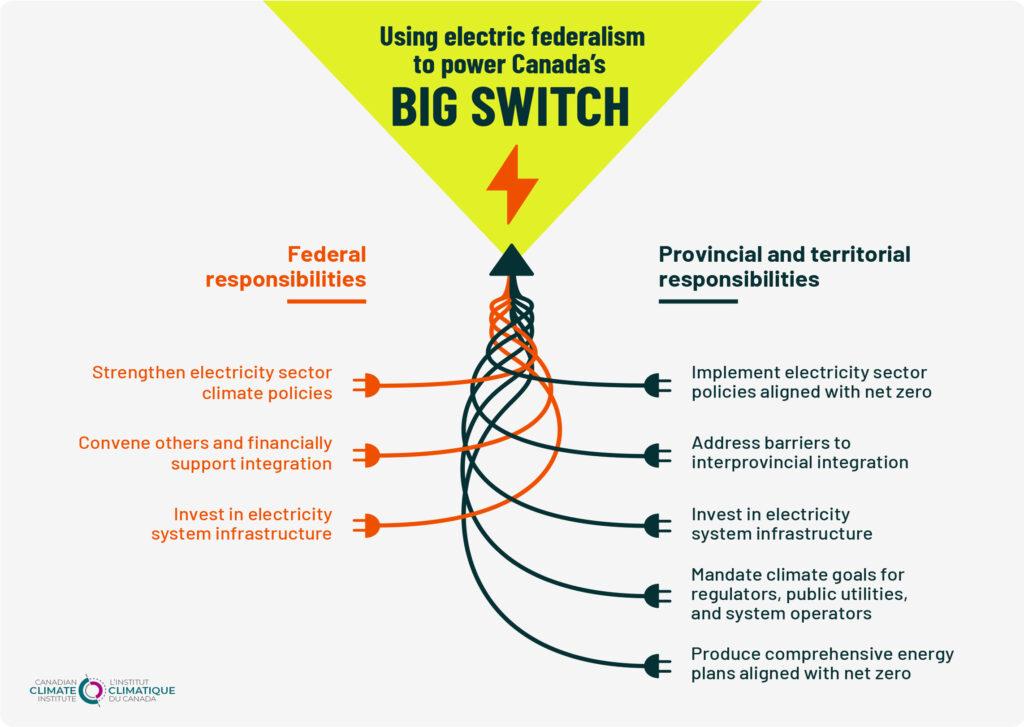Clean electricity will power Canada's net zero transition.
Reaching Canada’s climate targets requires a big switch from fossil fuel energy to clean electricity. This electricity transformation in Canada involves producing more clean electricity in every region. It phases out emitting sources, and uses clean electricity to power more and more of the economy. It will underpin Canada’s climate progress and power Canada’s future prosperity.
But getting there will require governments at all orders to leverage their policy tools—ideally in a coordinated way.
Transforming electricity in Canada will impact how nearly every household and business will use energy. The policy choices that governments make to align electricity systems with net zero are therefore extremely consequential. Getting it right—or wrong—will have big implications far beyond the electricity sector.
Electricity transformation in Canada
Acting early with smart policies can significantly reduce overall costs and make achieving net zero easier. Electricity transformations will require significant capital investment. Early and effective action, including initiatives to make electricity systems more resilient to the effects of climate change, allows Canada to avoid a more difficult transition later. It would entail higher consumer prices from stranded assets and from underbuilt systems struggling to keep up with growing demand. Acting now also reduces overall costs by driving innovation.
Strategic action today can unlock clean growth opportunities. Canadian companies active in low-carbon electricity, batteries and storage, and solar and wind equipment are well-positioned to grow in the global low-carbon transition. New sources of transition-consistent growth can offer export opportunities, employment, and prosperity for Canadians.
Electricity system transformations can be pursued in ways that support equity. Ensuring rates remain reasonable for low-income households could help address potential inequities.
Catalysing Indigenous participation and leadership can support Indigenous self-determination and reconciliation. Clean energy projects represent an important means of advancing reconciliation and the rights and well-being of Indigenous Peoples.
While the stakes are high, Canada is fortunate to have significant advantages to draw on for its electricity transformation. Over 80 per cent of its electricity production is already non-emitting thanks to its abundant hydroelectric resources. Electricity systems across the country are supported by robust institutions and structures that deliver reliable and affordable electricity. Building on these advantages can ensure Canada meets its climate goals while strategically positioning its economy to succeed in the global low-carbon transition.
powering the switch: BIGGER, CLEANER, AND SMARTER ELECTRICITY SYSTEMS
This section summarizes the findings of our technical pathways report Bigger, Cleaner, Smarter, describing the changes needed in Canada’s electricity systems to align them with net zero. Aligning electricity systems with net zero requires attention to all three changes—bigger, cleaner, and smarter.

MAKING ELECTRICITY SYSTEMS
BIGGER
Making electricity systems bigger means growing them to meet the increased demand from widespread electrification. In a net zero future, Canadian electricity demand will grow to be 1.6 to 2.1 times larger by 2050 compared to today. And to meet that demand, Canada’s electricity generation capacity will need to be 2.2 to 3.4 times bigger than today. To meet a “right size” electricity demand, significant improvements in energy efficiency are needed.

MAKING ELECTRICITY SYSTEMS
cleaner
Making electricity systems cleaner means phasing-out unabated fossil fuel generation, accelerating the growth of solar and wind, and maintaining hydro and nuclear power’s important role. To support net zero, 60-95 per cent of new capacity added by 2030 must come from solar and wind. Other technologies such as carbon capture, utilization, and storage applied to emitting generation, small modular reactors, hydrogen-fired electricity generation, and geothermal have significant potential. But their future role is more uncertain.

MAKING ELECTRICITY SYSTEMS
smarter
Making electricity systems smarter means ensuring they are flexible enough to support more variable energy from solar and wind. It also means that they’re more resilient to the effects of climate change. That can mean deploying sources that generate power on demand (e.g. hydropower), enhancing grid integration, scaling up battery storage, or using smart technologies to shift when power is used (e.g. electric cars programmed to charge during the night while demand is low). Many of the key flexibility technologies necessary to the electricity transformation in Canada are commercially available today. And their costs continue to fall.

Transforming electricity systems
Aligning electricity systems with net zero is both necessary and achievable. Transformations will vary across Canada: regions without abundant hydropower resources face different challenges than those that are hydropower-rich. Some solutions face technological barriers, while many others face social, political, or institutional ones.
Governments have a driving role in these transformations. Provincial and territorial governments are central in developing policy, given their authority over electricity systems. The federal government can set the national policy framework and act as an enabler of regional progress. Meaningful involvement of Indigenous Peoples in policy making and key decisions will also be required to achieve successful transformations. It will be necessary to ensure Indigenous Peoples continue to take a leading role in identifying and seizing clean energy opportunities. In short, policy interventions from different orders of government will be required to flip the switch.
FLIpping the switch: policy recommEndations for electric federalism
Our second report, Electric Federalism, identifies how Canadian governments can drive the transformations electricity systems require to achieve net zero.

what is
electric federalism?
Electric federalism requires provincial, territorial, and federal governments pulling their respective policy levers to transform electricity sytems. It requires them working together in a coordinated way to drive the energy transformation in Canada.

Recommendations for building electric federalism:
- The federal government should strengthen climate policy in the electricity sector. Significant policy gaps still remain, if the sector is to reach net zero by 2035. Federal climate policy in the electricity sector should provide sufficient incentives for non-emitting generation: for example, better incentives to ramp down use of unabated natural gas-fired electricity.
- Federal, provincial, and territorial governments should leverage public funds to defray the costs of electricity system investments for ratepayers. Proactively mitigating potential upward pressure on rates can support a smooth net zero transition.
- Provincial and territorial governments should flex their policy muscles in driving transformation of their electricity systems. Federal climate policies can help motivate greater integration. But it’s ultimately up to provinces and territories to choose how much they want to coordinate and integrate.
- Both orders of government should pursue greater coordination and integration using their respective policy tools. Federal climate policies can help motivate greater integration. But it’s ultimately up to provinces and territories to choose how much they want to coordinate and integrate.
- To enable and accelerate policy action, the federal government should consider offering sustained, predictable financial support to provinces and territories. In exchange, provinces should implement a limited number of high-level policy actions.
Want to learn more about the big switch?
Read our summary report, The Big Switch, for high level analysis, or dig into the technical pathways, Bigger, Cleaner, Smarter, or policy report, Electric Federalism, for more detail.

Project briefing video
In this 30-minute briefing, Jason Dion and Caroline Lee walk through the main findings and recommendations of The Big Switch.
See here for the briefing deck that Jason and Caroline present in the video.
Scoping Papers and Case Studies
As part of this project, the Institute has commissioned a series of scoping papers and case studies on key topics relating to electricity system transformation. The purpose of these papers is to generate new thinking and useful insights from recognized experts.
SCOPING PAPER: electricity affordability and equity in Canada's energy transition
BRETT DOLTER & JENNIFER WINTER
CASE STUDY: Nordic co-operation, Canadian provincialism
SHAWN MCCARTHY
SCOPING PAPER: Expediting Clean Energy Facilities in Canada: A framework for new fast-track permitting
RODNEY NORTHEY
SCOPING PAPER: Waves of change, Indigenous clean energy leadership
INDIGENOUS CLEAN ENERGY
SCOPING PAPER: Enhancing the resilience of Canadian electricity systems for a net zero future
ANNA KANDUTH & DYLAN CLARK
CASE STUDY: Germany's Energiewende 4.0 Project
CHRIS TURNER
SCOPING PAPER: Technical pathways to aligning Canadian electricity systems with net zero goals
BLAKE SHAFFER
SCOPING PAPER: Improving integration and coordination of provincially-managed electricity systems in Canada
PIERRE-OLIVIER PINEAU
SCOPING PAPER: Barriers to innovation in the Canadian electricity sector and available policy responses
SARA HASTINGS-SIMON
SCOPING PAPER: Enabling broader decarbonization through Energy Systems Integration
MADELEINE MCPHERSON
Other publications
REPORT: Clean Electricity, Affordable Energy
KATE HARLAND & JASON DION
OP-ED: How renewables can play a bigger part in Canada's electricity system
JASON DION & SARA HASTINGS-SIMON
OP-ED: Electric Federalism – An idea whose time has come
CHRIS RAGAN, ED GREENSPON & RICK SMITH
SUBMISSION: Clean Electricity Regulations – Public Update
JASON DION, EVAN PIVNICK, JOANNA KYRIAZIS
 Stay connected
Stay connected 
Get the next report from the Canadian Climate Institute.
Sign up to receive future research from the Canadian Climate Institute, as well as timely policy analysis, blogs, and event invitations.